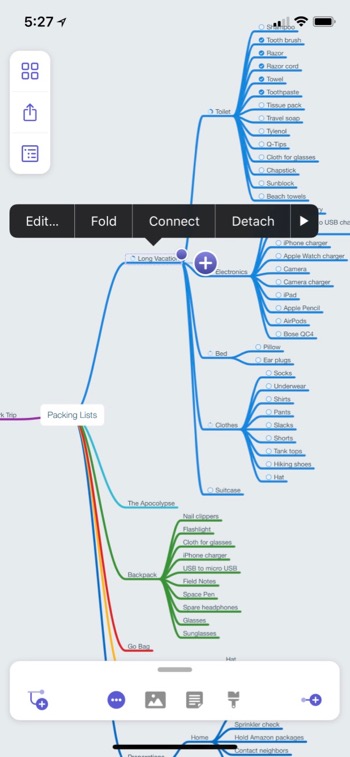
Without a solid task list, I tend, rather unfortunately, to ruminate on things that I can’t work on at the moment, distracting myself from the task at hand, or forget about them entirely. This little date field and the feature it exposes make OmniFocus the to-do list that best fits my life right now. When I have time, I file each task into a project and context (if it fits into any), add a due date (if it has one), and then fill in my very favorite field: the defer date. Blog posts, follow-up conversations, oil changes, books to read-everything. The Magical Box that Goes Ding When There’s Stuff: OmniFocusĮverything I have to do that I can’t do right now goes into my OmniFocus inbox. And because its canvas can hold any organized list, MindNode also helps me keep my head on straight throughout the day, letting me stay focused on what I’m doing without lugging around a box of notecards. Especially when I’m working with a new tech stack, making a map of the connections between individual components is one of the fastest ways I’ve found to help me think through a thorny debugging session or plan out new functionality. MindNode lets me get notes out of my head and onto a canvas quickly without the finality of paper or the publicity of a whiteboard.
#Mindnode 5 task mac
Remembering how well it worked back then, I grabbed the Mac version and tried it out at work. I’d thumb-type my way through the lecture at around 40 words per minute on an iPod touch, building up an outline and rearranging sections as I understood them better. Its infinite canvas and friendly UI made keeping up with most classes pretty easy. Then I remembered a little app I’d tried in college.ĭuring one of my especially minimalist semesters, I’d started taking lecture notes with one of the early mind-mapping apps on iOS, MindNode. But hogging a whole wall of the office for days at a time wasn’t exactly a great way to win friends. Easy to write on, easy to erase, with plenty of open space in a form that’s hard to lose. I could rearrange and shuffle cards around easily enough, but keeping my thoughts on paper was at odds with my backup practices.Ī whiteboard seemed like the perfect solution. If I wanted to reorganize things, forget it.įor a while, I used index cards. Every mark I made on the page would just sit there, immoveable and unchanging. I’ve tried keeping this amalgam in a notebook but found it stifling. Here’s why: My Personal Whiteboard: MindNodeĮvery morning, when I sit down at my desk, I want easy access to a short stack of tasks to complete and a blank canvas where I can sketch out ideas, notes, and diagrams of the systems I’m working with.

MindNode and OmniFocus are two that stuck.

Over the last few years, I’ve tried a slew of task management strategies to stay productive and sane at work. Working with a huge variety of languages, frameworks, devices, and humans is an amazing and invigorating way to spend the day, but keeping all of the relationships, interfaces, and syntaxes straight can be a tall order.


 0 kommentar(er)
0 kommentar(er)
